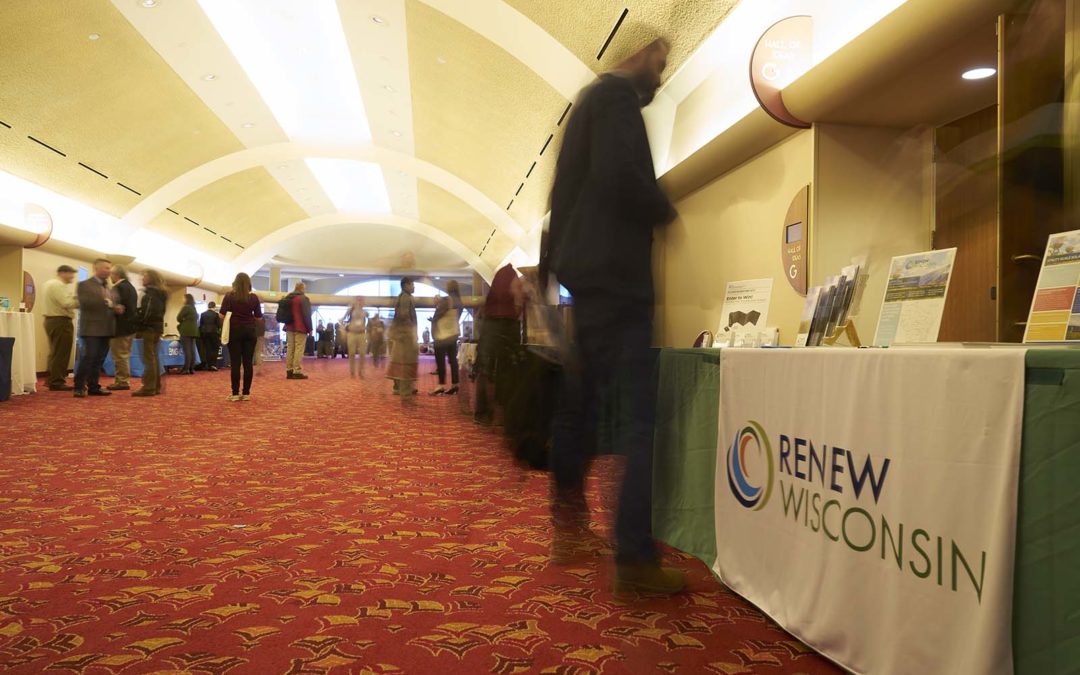
by Tyler Huebner | Jan 9, 2020 | Events
On Thursday, January 16th, RENEW Wisconsin will host its 2020 Renewable Energy Summit at the Monona Terrace from 8:30 a.m. to 3:30 p.m. The 9th Annual Renewable Energy Summit, with presenting sponsors Invenergy LLC, Zerology, and Arch Electric, is themed 2020 Vision: The Path to 100% Clean Energy, and will gather over 400 renewable energy industry experts, government officials, students, and advocates.
To register for the Summit, go to renewwisconsin.org/renewable-energy-summit/.
Clean, renewable energy is driving Wisconsin’s economy, strengthening national energy security, improving air quality, and supporting the overall quality of life for Wisconsinites. More than 40 expert speakers will discuss these clean energy opportunities and how we can work together to accelerate Wisconsin’s clean energy future.
New to the Summit this year, RENEW is offering two pre-Summit 101 sessions, one on Renewable Energy another on the Electric Grid, that will occur simultaneously beginning at 7:30 AM. As part of RENEW’s education mission, these events are free and open to non-Summit attendees as well as those attending the day-long Summit. However, individuals who wish to attend these 101 sessions must register here.
After a welcome at 8:30 a.m., policymakers will take center stage at 9 a.m. for a plenary panel titled, Policy and What’s Possible. Senator Robert Cowles, Representative Greta Neubauer, Representative Adam Neylon, and Public Service Commission Chairperson Rebecca Cameron Valcq will talk about how policy can help Wisconsin achieve a 100% carbon-free future.
At noon, Keynote Speaker Katherine Hamilton will address the audience to discuss her global perspective on clean energy before zeroing in on Wisconsin’s role, opportunity, and techniques for advancing this industry. Katherine is Chair of 38 North Solutions, a bipartisan clean energy consulting firm, and is well-known as one of the voices on The Energy Gang podcast produced by Greentech Media.
In addition to speaker sessions, the event will feature an industry exhibit with 48 organizations and an awards segment recognizing some of the most exciting and successful renewable energy projects of 2019.
RENEW Wisconsin Executive Director Tyler Huebner said, “We are so excited to have our members and stakeholders at our Annual Renewable Energy Summit to talk about the key issues, and how working together we can continue to grow this industry and opportunity for Wisconsin.”
Regular registration rates apply through January 12th with special rates for students and elected officials. Members of the media are welcome to attend for free but need to register beforehand.
Agenda – January 16, 2020 – Monona Terrace
7:30 a.m. Renewable Energy 101 or Electrical Grid 101 – Two entry level seminars to help newcomers learn the basics of renewable energy or how the electric grid works and how will it handle more renewable energy technologies like solar power, batteries and charging lots of electric vehicles.
8:30 a.m. Welcome and 2019 Energy Achievements
9:00 a.m. Panel: Policy and What’s Possible
- Public Service Commission Chairperson Rebecca Cameron Valcq
- Senator Rob Cowles, Chair, Senate Committee on Natural Resources and Energy
- Representative Greta Neubauer, Member, Assembly Committee on Environment
- Representative Adam Neylon, Member, Assembly Committee on Energy and Utilities
9:45 a.m. Renewable Energy Stories
10:15 a.m. BREAK
10:45 a.m. Breakout Sessions
- Biogas in Wisconsin’s Carbon-Free Future
- Electric Vehicles Driving Renewable Energy Growth
- Energy Storage
- Transitioning from Coal to Renewable Energy
11:30 a.m. LUNCH
12:00 p.m. Keynote Speaker, Katherine Hamilton, Chair of 38 North Solutions, specializing in clean energy and innovation and one of the voices on The Energy Gang podcast.
12:45 p.m. Awards
1:00 p.m. BREAK
1:30 p.m. Breakout Sessions
- Educating Wisconsin’s Renewable Workforce
- Large Scale Wind and Solar
- Advancing Distributed Generation
- Community-Led Clean Energy
2:30 p.m. Panel: 2020 Vision, How Do We Get to 100% Clean Energy • It’s easy to talk about the transition to 100% clean energy, but how can Wisconsin ACTUALLY make this happen?
- Shree Kalluri, Zerology, Founder and CEO
- Russell Minick, Generac Power Systems, Chief Marketing Officer
- Nichol Toomire, Alliant Energy, Director – Resource Planning, Energy Markets & Fuel Supply
3:15 p.m. Closing Remarks
3:30 p.m. Social Hour
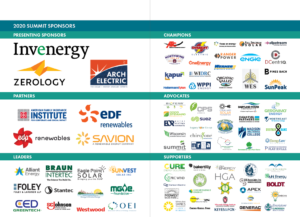
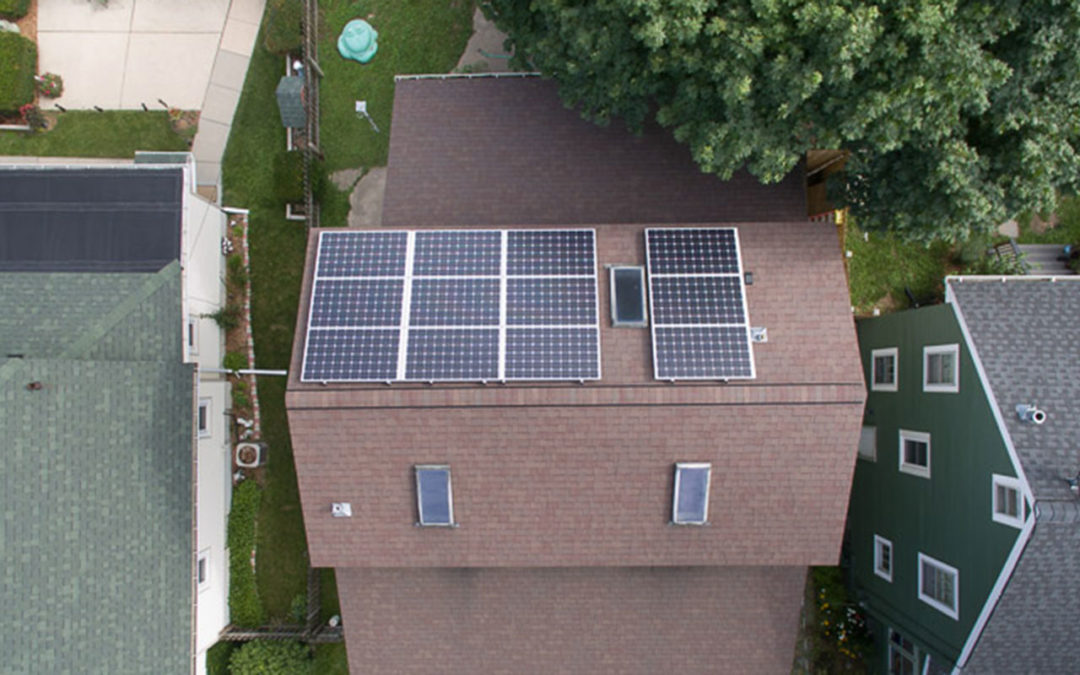
by Tyler Huebner | Jan 8, 2020 | Focus on Energy, Renewables, Solar
The Focus on Energy Renewable Energy Program had another very solid year in 2019. Late last year, the PSC approved several substantive changes in program offerings that will affect the renewable energy industry and its customers going forward. Renewable energy businesses and their customers need to learn about these changes.
First, let’s see how 2019 fared!
Focus on Energy Renewable Energy Program – 2019 Results
For non-residential customers, incentive totals declined slightly in 2019, but substantially fewer PV projects received funding: 135 in 2019 compared with 220 in 2018. At the same time, the average system size increased to 75 kW, up from 48 KW a year ago.Nearly the same number of homes received incentives in each of the past two years – 768 in 2019 compared with 750 in 2018. But more dollars were allocated in 2019 (up from $1.2 million in 2018), because system sizes were larger (7.2 KW in 2019 vs. 6.2 KW in 2018).
Geothermal continued a strong showing, with 77 total installations in 2019, compared with 68 in 2019. In addition, a small wind project received funding in 2019. No biogas projects were funded in 2019.
Changes to the Focus on Energy Renewable Energy Program for 2020
The Focus on Energy renewable energy program will undergo several important changes in 2020 – partly as a result of the trends seen in 2019. Throughout November and December 2019, the Public Service Commission voted to approve these changes, which Aptim, the Focus on Energy administrator, implemented on January 1, 2020.
First, Focus incentives for solar electric (photovoltaic or PV) projects will undergo the biggest change. In a move that many of our members desired to improve their sales cycle, Focus will be changing to “first-come, first-serve” prescriptive incentives for ALL solar PV projects starting in 2020.
However, as demand is expected to remain strong, the elimination of the competitive incentive program for larger PV projects means that fewer dollars will be available for individual projects. This is especially true for larger PV systems. Whereas a customer in 2019 could apply for a maximum incentive of $400,000 through the competitive program, this year the maximum incentive is set at $60,000.
The rationale for this change is to spread available funding across more solar PV projects and incentivize smaller PV projects. We had members with a multitude of opinions on this change, but this is what the PSC and Aptim, respectfully, have landed on.
The tables below shows the 2020 Solar PV incentive levels.
Residential Customer Solar PV Incentives
Business Customer Solar PV Incentives
At the bottom of this post, I’ve included a number of additional details about the 2020 solar program. You can learn more about 2020’s solar program at https://focusonenergy.com/residential#program-renewable-energy
Second, the competitive (RECIP) program will continue for other types of renewable energy projects, such as biogas, small wind, solar thermal, or biomass technologies. The hope is that by taking solar PV out of that competitive program, other technologies may have a better chance of getting funded.
Third, geothermal technologies will be moving out of the Renewable Energy Program in 2020. Residential geothermal incentives will be $750, and information can, for now, still be found under the residential renewable energy page. For buildings (i.e. “non-residential”) installations, geothermal will be treated like any “custom” energy efficiency measure.
Fourth, for Biogas there will still be grants available to conduct Biogas Feasibility Studies in amounts up to $15,000. In addition, biogas projects can compete in the RECIP competitive grant process. You can learn more about these opportunities at https://focusonenergy.com/business/renewables.
Here are additional details on the Focus on Energy Solar PV Program for 2020. These details were provided by Focus on Energy in late 2019 via email to their renewable energy trade allies.
Summary of Renewable Rewards updates for 2020
- The Rural portion of the program will be for residential customers and Agricultural Producers.
-
-
- Residential Rural customers will get up to a $500 bonus for installing a system. Bonus can’t be larger than prescriptive incentive. It will be equal to the incentive amount or $500, whichever is smaller.
- Agricultural Producers (Business customers) will qualify for an incentive match up to $10,000.
- Agricultural Producers are defined as “businesses engaged in the production of grain, livestock, milk, poultry, fruits, vegetables, bees and honey; fish; shellfish; or other common agricultural products including greenhouses.
- A Reservation system will be put in place for all projects.
-
- Residential customer projects will have three (3) months to complete.
- Business customer projects will have six (6) months to complete.
- There will not be a down payment requirement to reserve funding.
- Projects without a proposed completion date will be moved to the back of the queue.
- Reservation form will be posted on the website on January 3, 2020.
- All Reservations and Applications will be done online. If a customer or Trade Ally is unable to use an online version, the Program will provide them with a PDF version upon request, but it will not be available on the website.
- Azimuth rules: All projects within 90 degrees of due South (Compass Direction of 90 to 270 degrees) will be eligible for incentives and will receive the same incentive amount, regardless of azimuth.
- Projects completed in 2019 will get the 2019 incentive rate (will have 60 days from completion date to submit application).
- Projects completed in 2019 will receive the 2019 incentive rate (will have 60 days from completion date to submit application).
- Residential projects that began construction prior to November 1, 2019, and will complete before January 31, 2020 will be eligible for the 2019 incentive rate.
- Commercial projects that began construction, signed contracts, or signed purchase orders prior to November 1, 2019, but will not complete until 2020, will be eligible for the 2019 incentive rate only (12% of project cost, up to $4,000)
- Projects that sign contracts or purchase orders after November 1, 2019, and complete in 2020, will be eligible for the 2020 incentive rate.
- The total budget for Renewable Rewards is set at $4,000,000. The budget will be divided between the following customer groups and project sizes:
-
-
- Remaining funding will be posted on the website and updated every two weeks.
- For business customers: if funding in one tier is exhausted, the customer will have the option to reserve funding for the maximum amount in a smaller tier, provided funding is still available.
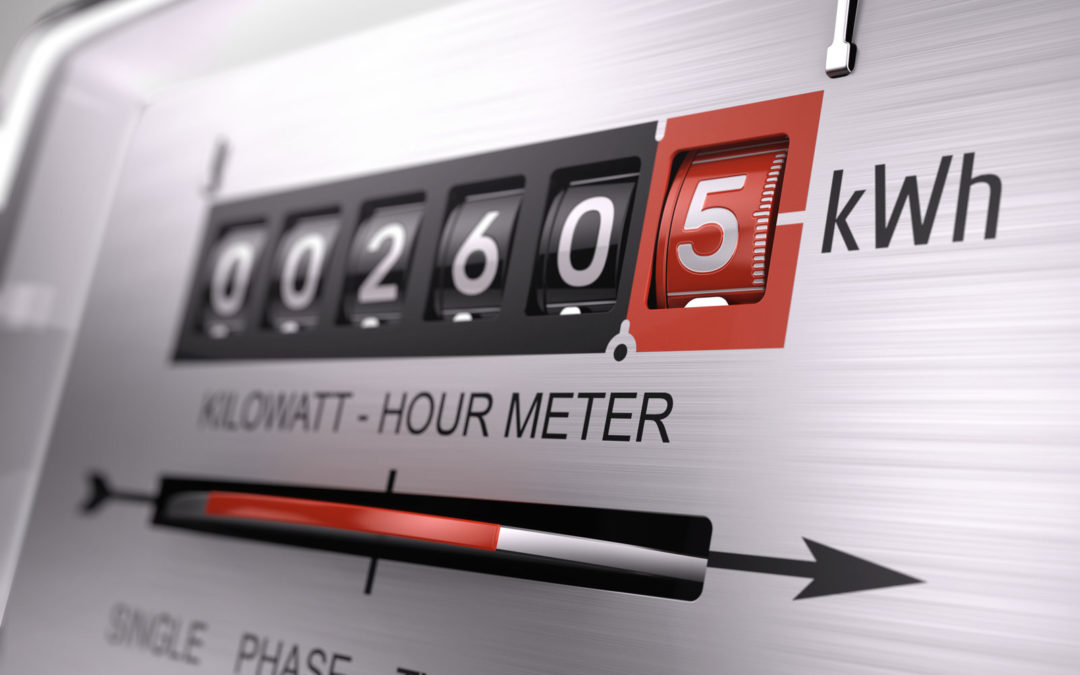
by Tyler Huebner | Jan 7, 2020 | Renewables, Solar, Utilities
Our goal is to streamline the process for renewable energy installations and utility reviews.
Over the past two years, RENEW Wisconsin has been actively working as a member of the Wisconsin Distributed Resources Collaborative (WIDRC) to modernize and improve the necessary forms for applying to install a new distributed generation (DG) system in Wisconsin.
We are excited to help spread the word that as of January 1, 2020, the new forms are available and recommended for use!
These forms represent one of the first formal steps in the process of getting approval to install a new distributed generation system in Wisconsin. Distributed generation systems include solar electric (photovoltaic), small wind, battery energy storage, biogas or biomass electric generators, and/or other technologies that fall under Wisconsin Administrative Code Chapter PSC 119.
Access the New Wisconsin DG Application Forms
Distributed generation installers must complete these forms and submit them to their local electric provider to start the process of obtaining the ability to “interconnect” with the local electricity grid.
You can download the new forms here. See the right-hand column “New Wisconsin Interconnection Forms” for the links to each form.
These DG application forms replace the 6027 and 6028 forms and consolidate the information needed into one “base” form, the Wisconsin Standard Distributed Generation Application Form. Then, installers will fill out a more streamlined technology-specific form to provide the information on which type of distributed generation system(s) will be installed.
The forms are fillable in PDF and can be digitally saved to speed up the process. In addition, the forms now clarify that each size category for DG systems is based on AC electricity ratings.
Installers should continue to use the same 6029 (20 kilowatts and under) and 6030 (above 20 kilowatts) Interconnection Agreement forms when the system is ready to be interconnected to the utility.
Reducing Solar “Soft Costs”
Improving these forms is one of many activities we are undertaking to reduce the “soft costs” of installing solar and DG systems in Wisconsin. In particular for solar, where approximately 1,000 systems are now being installed annually in Wisconsin, we’re looking to save time in the permitting, inspection, and interconnection processes. Time saved in each of those processes will add up quickly when installers are doing it one thousand times each year!
To make this happen, Jodi Jean Amble, our Communications & Events Director, spent a lot of hours designing and constructing these new forms to be very user-friendly. We are hopeful these forms will make the DG application process a little bit easier for our members and all the companies that need to use them.
To learn more about this process and update, please check out this letter that was provided to Wisconsin electric utilities and DG installation firms.
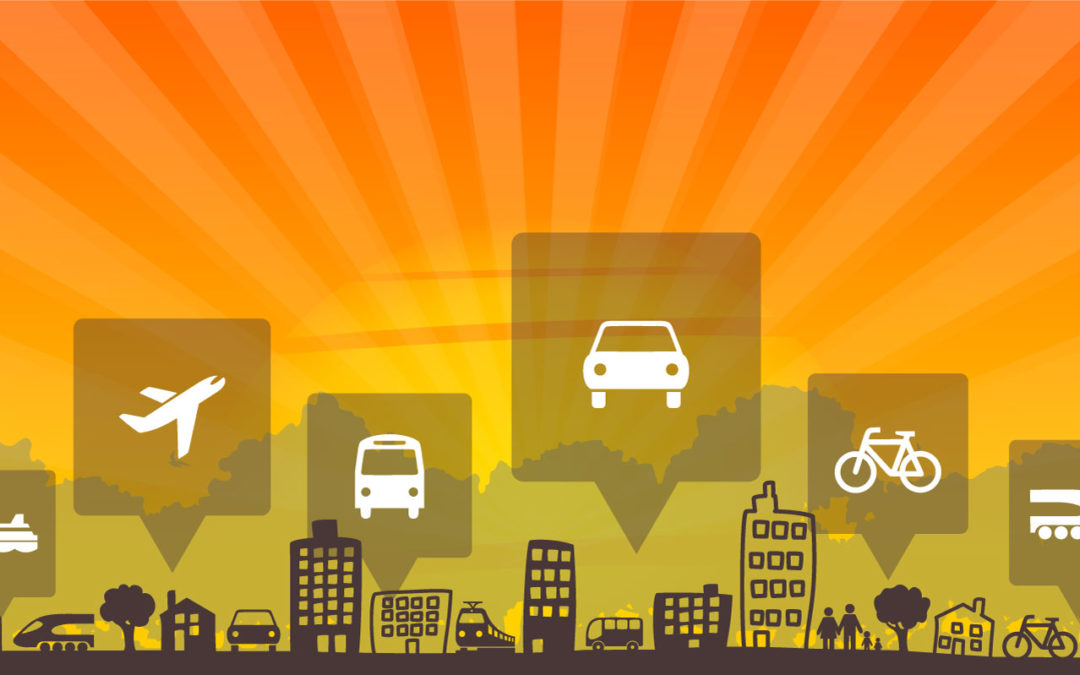
by Jane McCurry | Dec 31, 2019 | Electric Vehicles, Sustainability
In the very first edition of the RENEW Wisconsin Electric Vehicles Blog, I shared my transportation story. That was over a year ago, and now we are approaching a new decade, which will be sure to bring just as much change as the last. Here’s a quick rundown of what I see as the biggest transportation changes over the past 10 years, what’s coming next, and how I plan to clean up my own transportation use in 2020.
10 years of transportation
In 2010, 3 days after my 16th birthday I got my driver’s license, kickstarting my experience with personal transportation.
In 2015, I purchased a red (Go Badgers!) 2010 Ford Escape. I didn’t even think about buying an electric car. Sometimes, I opted to drive my car because it was warm and easy, despite having the option to reduce my emissions by walking, taking the bus, driving my moped, or biking.
Then, in July of 2018, I started working at RENEW. I was immersed in clean energy – and quickly realized that my transportation choices didn’t align with my values.
I spent a year learning as much as I could, evaluating my lifestyle, and crunching the numbers on an EV purchase. I bought a Tesla Model 3 and moved to an apartment with solar on the roof. My husband and I are an all-electric, one car household. I call a rideshare when I need it – and in Madison, I can call an all-electric rideshare with Green Cab.
This is not the transportation future I imagined when I started my transportation story in 2010. I have more options, and produce fewer emissions, than I could have imagined 10 years ago. Madison is a walkable city that has an all-electric cab company, BCycle electric bikeshares, beautiful bike paths, and an extensive bus system that is being renovated and electrified. I can (and do!) take advantage of these options to live my clean energy values more fully.
A clean energy resolution
As I reflected on my personal transportation choices this decade, I decided to make Clean Energy Resolutions for 2020:
- Buy carbon offsets for my air travel.
- Try not to rideshare alone. I will bus when possible and call a Green Cab when I need to, reducing my solo rideshare trips (it’s not really “sharing” when I’m the only one in the car that needs to go there).
How has your personal transportation evolved over the decade? What would your Clean Energy Resolutions be?
Here are a few options to dip your toe into a clean energy transition this year:
- Pledge to take the bus once a week in January
- Instead of a “swear jar” have a “lights jar” at home – anyone caught leaving a light on when they’re not in the room owes the jar $1
- Take part in National Bike to Work Day this May, bonus points if you get coworkers involved
- Look into your utility’s green power program, or other ways to offset your home’s electricity use, like solar
- Test drive an electric car (I bet you’ll like it!)
- Become a RENEW Sustaining Member
- Get a solar site assessment – at home or your work – to see if solar is right for you. See our list of trusted installers here
What will next decade hold?
This decade saw a lot of change in the way people get around. Rideshares like Uber and Lyft became common, electric scooters took over sidewalks nationwide, and electric vehicle sales tipped over 1 million in the U.S.
I expect that next decade it will be even easier to get around with enhanced micromobility options, cleaner buses with more bus routes, and more electric vehicle models than ever. These transitions are happening nationwide and Wisconsin is no exception. In addition to Madison, La Crosse, Milwaukee, and Racine all have electric buses ordered. Madison is working toward bus rapid transit, which will make commuting faster, cleaner, and more equitable for thousands of Wisconsinites. Micromobility is happening everywhere too – the founder of Bird Rides, one of the big scooter-sharing companies, grew up in Appleton! And, there are bikeshares in cities as small as Wisconsin Rapids and as large as Milwaukee. Together, these options will make it easier to get where you need to go, with fewer emissions.
For passenger vehicles, expect 200 different EV models to be available by 2025, giving us more size, shape, price, and brand options in the electric vehicle market. To add to it, I am really excited to see how the transition to autonomous vehicles will play out, especially as we transition to electric and shared mobility at the same time.
Buckle up, it’ll be a fun ride!

by Tyler Huebner | Dec 19, 2019 | Public Service Commission, Renewables, Solar, Utilities, Utility Scale
Today, the Public Service Commission of Wisconsin approved the Point Beach Solar Farm project!
Point Beach will be a 100 megawatt solar farm, and will supply electricity to WPPI Energy. WPPI is a wholesale energy provider for 41 municipal utilities in Wisconsin plus 10 more across Michigan and Iowa. The developer is NextEra Energy Resources, one of RENEW Wisconsin’s newest Business Members.
Almost three years ago, WPPI Energy made a splash by announcing the results of a request for renewable power proposals. At the time, wind energy was expected to be the winner of that competition. But this solar farm proposal was selected, foreshadowing how cost-effective solar power was becoming in Wisconsin.
Since then, other major power suppliers have followed WPPI Energy’s lead. In April 2019, the PSC approved the Badger Hollow and Two Creeks Solar Farms. Along with the 49.9 megawatt Richland County Solar Farms which was approved at the County level, these projects marked the first utility-scale solar approvals in Wisconsin.
This Point Beach Solar Farm will be placed on ground right around the existing Point Beach Nuclear Energy plant. It will also be located next to the Two Creeks Solar Farm now in construction, with the two projects combining to provide 249 megawatts of solar capacity in Manitowoc County.
With today’s PSC approval in hand, construction will begin next year and it should come online in 2021. It is expected to provide enough energy to serve more than 23,000 people.
Congratulations to NextEra Energy Resources and WPPI Energy on this project approval!
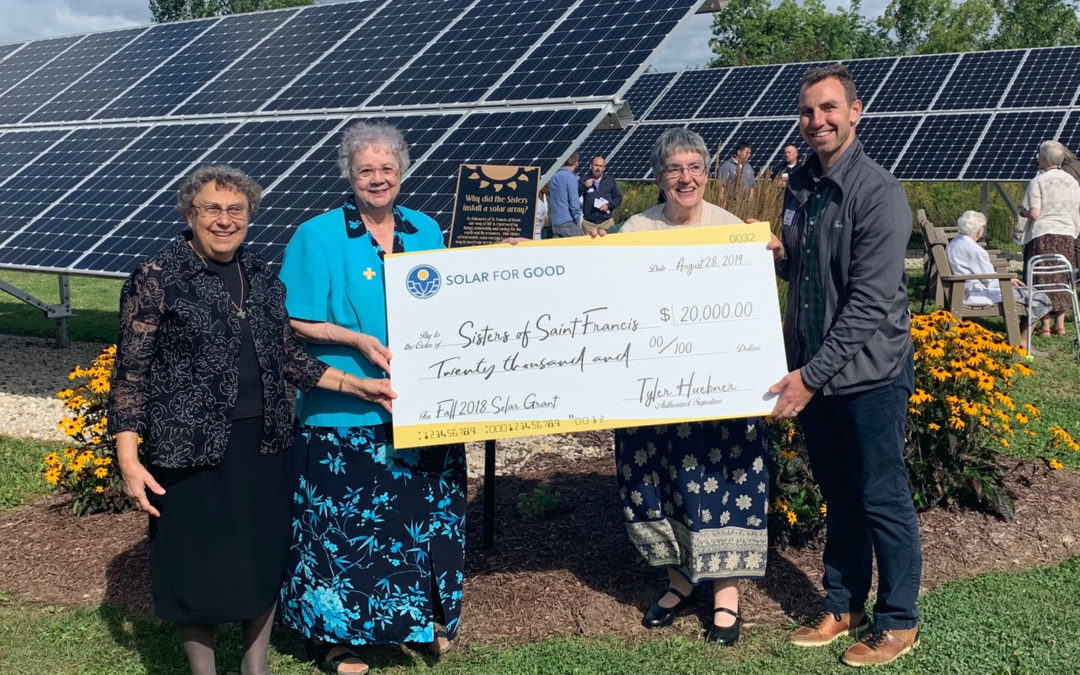
by Sam Dunaiski | Dec 16, 2019 | Community, Local Initiatives, Programs, RENEW Wisconsin, Solar, Solar for Good
RENEW Wisconsin’s Solar for Good program will issue nearly $140,000 worth of solar panels to Wisconsin nonprofits as part of their fall 2019 funding cycle. These grants will go to 13 organizations across the state that together will install nearly 600 kilowatts of clean, renewable electricity. When completed, these solar projects will lead to over $1.2 million of solar investment in Wisconsin.
The following organizations have been offered Solar for Good grants to install new solar electric systems:
CAP Services, poverty alleviation, Stevens Point
Camp Amnicon, outdoor retreat and spiritual worship, South Range
Menīkānaehkem, Native American educational organization, Gresham
Habitat for Humanity – La Crosse Area, affordable housing provider, La Crosse
Jackson County Animal Shelter, safe haven for stray animals, Black River Falls
Heartland Housing, affordable housing provider, Madison
First Unitarian Society of Milwaukee, house of worship, Milwaukee
Boys & Girls Club of Greater La Crosse, youth education, La Crosse
Bethel Lutheran Church, house of worship, Madison
Movin’ Out, alternative housing provider, Madison
Zwingli United Church of Christ, house of worship, Verona
Kathy’s House, alternative housing provider, Wauwatosa
One organization has asked to remain anonymous at this time.
This round of Solar for Good funding features a diverse group of awardees from across Wisconsin. The Boys and Girls Club of Greater La Crosse will use their solar installation to help educate members on renewable electricity and energy efficiency for their recently-renovated facility. Over 200 solar panels will be installed at Kathy’s House, a hospital guest-house in Wauwatosa. And the Indigenous-led organization Menīkānaehkem, will install solar to power several tiny homes being constructed on the Menominee Indian Reservation to house the community’s homeless population.
“We decided to go solar to reduce our energy bills and to focus more of our resources on programming,” said Guy Reiter of Menīkānaehkem. “We plan to use the array as a training center for community members interested in pursuing a career in solar. Thanks to the Solar for Good grant, we are moving closer to our goal of making the Menominee community energy-sovereign as a way to create jobs, restore hope, reduce carbon pollution, and mitigate climate change.”
This marks Solar for Good’s 5th funding cycle and the second-largest to date. Including the fall 2019 funding cycle, the program’s impact will total 74 Wisconsin nonprofits installing 88 new solar arrays throughout the state. The program will add 3.25 megawatts of clean, renewable power to Wisconsin’s electric mix, enough to power approximately 650 homes. In total, these 88 solar arrays will spur over $7 million in investments in renewable electricity.
About Solar for Good
RENEW Wisconsin’s Solar for Good initiative fosters the expansion of solar power among mission-based nonprofits and houses of worship in Wisconsin. Through a generous partnership with Couillard Solar Foundation, RENEW Wisconsin awards solar panels to nonprofit organizations, helping them switch to clean, renewable, solar energy.
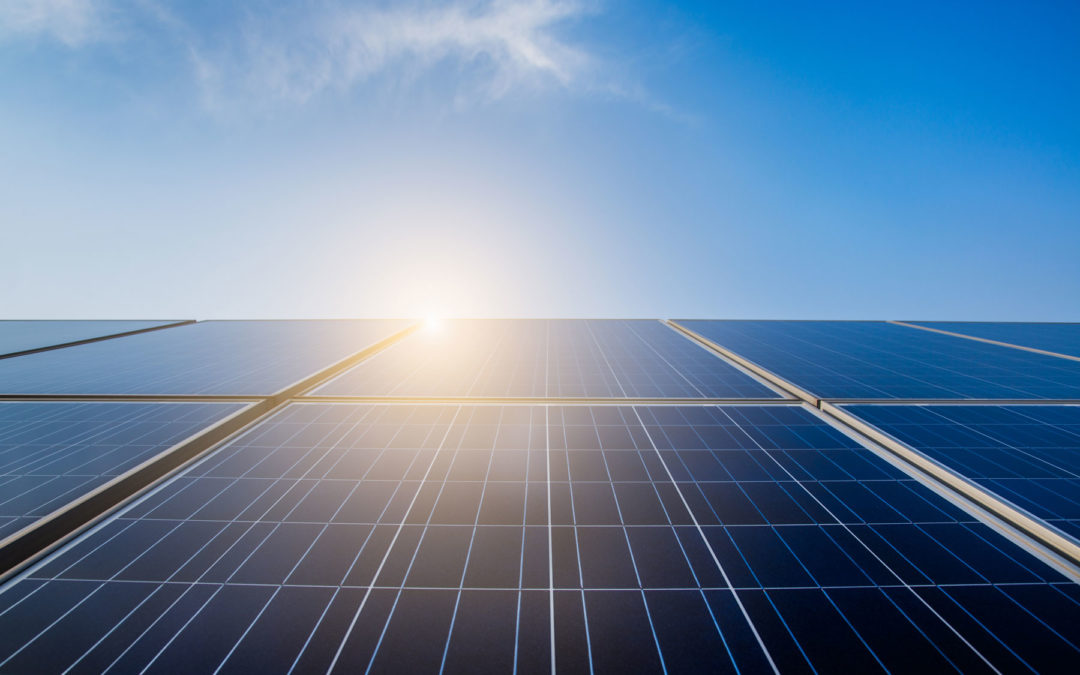
by Tyler Huebner | Dec 3, 2019 | RENEW Wisconsin
RENEW Wisconsin has partnered with Madison Community Foundation (MCF) to offer a charitable gift annuity.
What is a charitable gift annuity?
Like other annuities, a charitable gift annuity offers a regular stream of income on an initial investment until your death. However, charitable gift annuities are a form of planned giving and therefore differ from other annuities in several ways.
Here is how the charitable gift annuity works:
- You make a donation to a nonprofit organization, such as RENEW Wisconsin, and take a partial tax deduction.
- MCF, as the holder of the annuity funds, invests the funds on behalf of RENEW Wisconsin and pays you (the annuitant) a regular payment until your death. A portion of this income also may be tax exempt.
- After your death, the balance of the invested funds go to the nonprofit organization (RENEW Wisconsin, in this case).
The amount of your tax deduction depends on a number of factors, including your age at the time you establish the charitable gift annuity, the size of your donation, and whether the annuity is for a single person or a couple. You should consult with your tax advisor to determine the specific tax benefits for your situation.
Who can set up a charitable gift annuity?
The gift annuity is available for donors who are 60 and older. MCF requires an initial investment of $10,000, and offers an interest rate on the gift that ranges from 4.3% for a single 60-year-old to 9.3% for a couple who are both 95 and older. (There is no upper limit on investments.)
Whatever is left in the fund at the time of your death will be put into RENEW’s endowment fund with MCF. This fund supports Energy Analysis & Policy (EAP) graduate student interns at UW-Madison’s Nelson Institute who are working at RENEW. The endowment was created by an MCF grant and gifts from EAP alumni and RENEW members a few years ago.
As an example, a 71-year-old, single RENEW member recently established a gift annuity with MCF for RENEW. He made an initial investment of $10,526. Based on his age and the amount of his initial investment, his annuity earns an interest rate of 5.7%, or $600 a year, which is paid quarterly. He was eligible to take a tax deduction of $3,527, and $460 of the annual income is tax free.
The gift annuity is ideal for people who are older than 60, looking for a higher interest rate than offered by certificates of deposit (CDs) for their savings, and who want to support a nonprofit, even after death. The charitable gift annuity through MCF is designed to have a residual amount of at least 50% of the original gift for the charity. In 2017, the average amount left for charities from charitable gift annuities using the same rates (those recommended by the American Council on Gift Annuities) was 62% of the initial contribution.
For more information, contact Heather Allen at RENEW Wisconsin (608.255.4044 or heather@renewwisconsin.org) or David Koehler at MCF (608.232.1763 or dkoehler@madisongives.org).
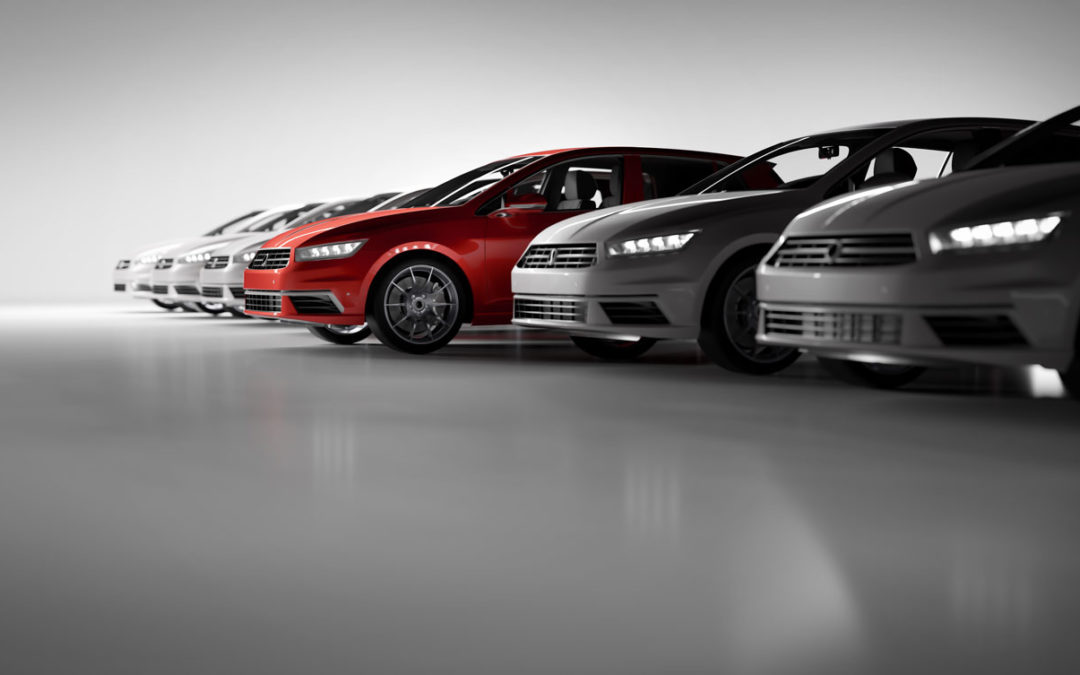
by Jane McCurry | Nov 26, 2019 | Electric Vehicles
The Energy Gang, a Green Tech Media (GTM) podcast, dives into energy, clean technology, and environmental issues. We’re very excited to welcome Katherine Hamilton, one of the show’s co-hosts, as our keynote speaker at our annual Renewable Energy Summit to take place on Thursday, January 16, 2020! Katherine is also the Chair of 38 North Solutions, a public policy firm focused on clean energy and innovation, which she co-founded.
While we wait for Katherine’s visit to Wisconsin in January, we’re listening to The Energy Gang Podcast. I was especially intrigued by the October 26 episode, “Who’s Trying to Re-Kill the Electric Car?” The title is a spoof on the film, Who Killed the Electric Car? which came out in 2006. The documentary is a reminder of previous attempts to make electric vehicles mainstream. In 1997, after a California air emissions mandate, General Motors launched the EV1, the first electric vehicle made for the mass market. After only 6 years on the market, the EV1 was recalled and the vehicles were destroyed.
This Energy Gang episode digs into the question: Are we in the midst of the same story at a grander scale?
Who (if anyone) is re-killing the electric car?
There is certainly momentum in the EV market that points to a long and prosperous life for today’s electric cars. Bloomberg New Energy Finance says 57% of passenger vehicles sales could be electric by 2040. EVs are already cost competitive, with a lower cost per mile to operate and very little maintenance.
With more and more electric vehicles, we demand less and less gasoline. This sets up an interesting dynamic between oil companies and electric utilities. While these industries have often agreed (or left each other alone) on big policy issues, they’re beginning to fight over the market to fuel our vehicles.
We’re just beginning to see how this conflict will play out. Transportation is a huge market – Wisconsin alone spends $8.4 billion per year (yes, that’s billion with “b”) to fuel our vehicles, all of which is sent out of the state, and much of it out of the country, to purchase liquid fossil fuels to run our vehicles.
It’s no surprise that oil and gas companies see electric vehicles as a threat. In fact, many of them are pivoting to include electric vehicle charging in their line of services. In Europe, gas companies own a lot of the public charging infrastructure and BP recently bought Greenlots, a charging station software provider.
What about our local gas station owners? The Energy Gang says they don’t seem to care that much, but they are considering installing EV chargers. Gas stations could somewhat easily switch from one fuel to another, and keep people buying items in their convenience store, where they make the bulk of their profits.
How to Make Sure EVs Survive This Time
Utilities stand to gain from a growing electric vehicle market, and they are catching on fast. As energy efficiency has made big gains, overall electricity consumption is growing more slowly than it has in the past. Electrifying vehicles and other appliances is a real growth opportunity for power companies. Five years ago, utilities weren’t proposing programs to promote electric vehicles except in California. Now, utilities in 25 states have plans to invest in public electric vehicle charging.
In those 25 states, at least 10 have oil-affiliated groups pushing back. In Wisconsin, we are working hard to get the facts out about electric vehicles and make sure consumers and decision-makers understand the benefits of this transition, and the downsides to our current, expensive transportation fuel:
- EVs are for everyone. EVs are already cheaper to own and operate, and the costs of the vehicles themselves are coming down fast.
- EVs are better for the environment and will continue to get cleaner as our grid gets cleaner. Internal combustion engines, on the other hand, only get dirtier over time.
- In our view, power companies, government, and private businesses should be working together to build the charging network needed to support these vehicles, just like we built roads when cars first came along.
We’re watching this story unfold in Wisconsin. The Wisconsin Public Service Commission opened a docket to investigate the electric vehicle market and explore the roles that utilities and regulators could take in this new market. Stakeholders are welcome to participate in this docket. So far, dozens of organizations and individuals have submitted comments ranging from supportive and excited to questioning or downright anti-electric vehicle.
Our hope is this docket will help to build clarity and momentum in the market. We have allies who also believe in this transition, and we will continue working together to make sure the electric vehicles of today survive.
Consumers are driving the transition
Electric vehicle adoption will be in an exciting transition and one that I’m grateful to take part in. I was 2 years old when the 1997 EV-1 came to market. Had it not been “killed,” maybe my first car would have been electric? We’ve come a long way since then. Now, consumers are driving the EV market and demanding high quality electric cars. The market is delivering and we should keep it thriving.
If you want to learn more about electric vehicles and clean energy, you should attend our Renewable Energy Summit on January 16, 2020 in Madison, Wisconsin! Keynote Speaker Katherine Hamilton will be discussing these issues and more. Our Presenting Sponsors are on the cutting edge of our clean energy future, with Invenergy developing large-scale solar and wind projects and Zerology establishing the nation’s first all-electric taxi fleet!

by Tyler Huebner | Nov 1, 2019 | Renewables, Solar, Utilities
Yesterday, Alliant Energy’s Wisconsin Power & Light utility company announced plans to add 1,000 megawatts of solar power by 2023 to provide more clean, renewable energy to their Wisconsin customers.
By our analysis, this commitment to solar power would equate to:
- About 2.7% of Wisconsin’s entire electricity consumption
- Enough electricity to provide the annual needs of about 250,000 Wisconsin residential electric customers
- An estimated $5,000,000 annually in land leases paid to landowners who would lease their land to the solar projects
- $4,000,000 annually provided across the local townships and county governments where the projects are located (if in Wisconsin), allocated through the state’s utility shared revenue formula
- Create about 1,600 jobs during construction
- Currently Wisconsin uses about 9,200,000 acres as farmland and has 34,700,000 total acres of land. The approximately 7,000 acres of solar would sit on just 0.076% of Wisconsin’s farmland and 0.020% of Wisconsin’s total land.
- With appropriate grassland and pollinator-friendly practices, the land under these solar arrays can provide numerous benefits by regenerating soil, supporting pollinators like bees and butterflies, and removing carbon from the air and burying it in the soil.
Tyler Huebner, RENEW Wisconsin’s Executive Director, issued the following statement: “This is another important announcement signifying solar power’s time has come in Wisconsin. The costs for solar power have declined about 80% in the past decade, making solar a cost-effective source of electricity for Wisconsin customers.”
Huebner continued: “In addition to utility-scale solar development, RENEW Wisconsin and our members know that solar on homes, buildings, and in our communities also provide tremendous benefits and we look forward to working with Alliant and other utilities to ensure distributed generation and other renewable resources have a fair and equal shot, and receive fair and equal treatment, at providing their benefits as the state continues to shift towards more homegrown, healthy, and smart renewable energy.”
Alliant also announced they will build the first of their “community solar” projects, a program previously approved by the Public Service Commission, in Fond du Lac.
For context, Wisconsin currently has approximately 130 megawatts of solar. In April 2019, approximately 500 megawatts of solar in Wisconsin were approved (450 megawatts were approved by the Public Service Commission and nearly 50 megawatts were approved by the Richland County Board).
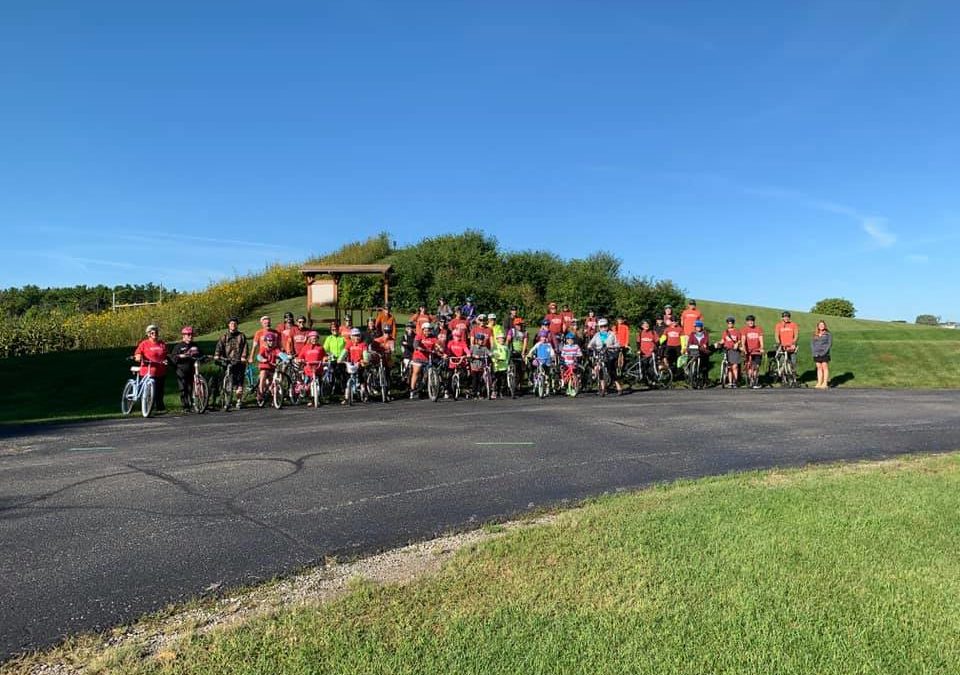
by Tyler Huebner | Sep 30, 2019 | Community, Electric Vehicles, Events, Geothermal, Hydroelectric, RENEW Wisconsin, Renewables, Solar, Wind
On Saturday, September 14th, our 7th Annual “Ride with RENEW” bike ride, held in the Fox Cities this year, was a huge success!
We started the morning at Prairie Hill Park in Grand Chute with 40 determined bike riders and 12 wonderful young ladies from the Girl Scouts of the Northwest Great Lakes! The State Representative for the area, Amanda Stuck, welcomed our riders by talking about the importance of energy, and how easy it has become to take advantage of clean energy sources.
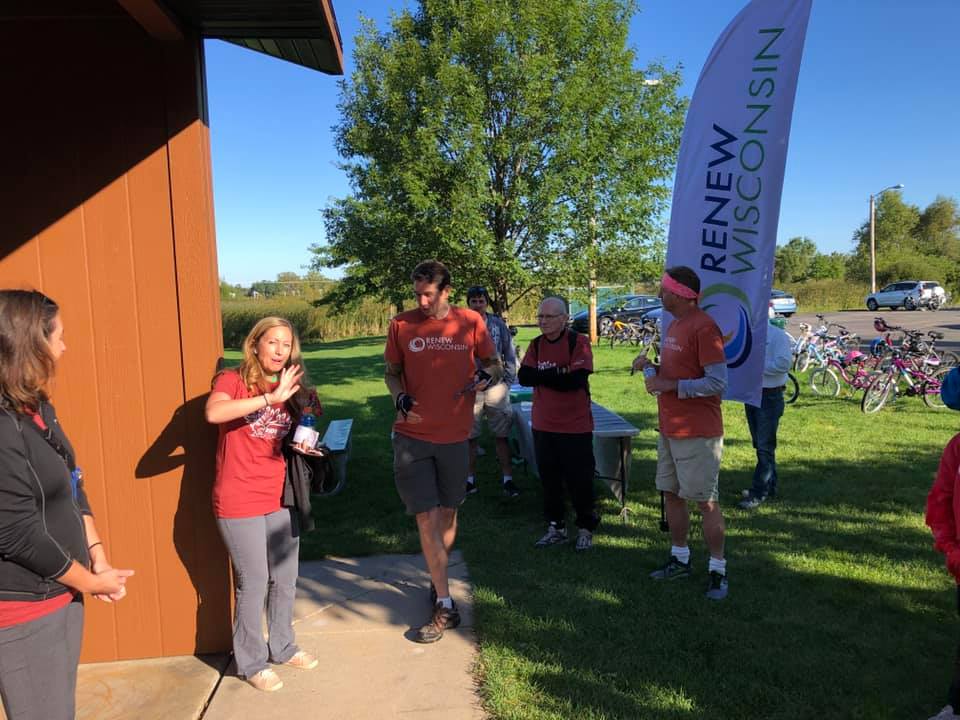
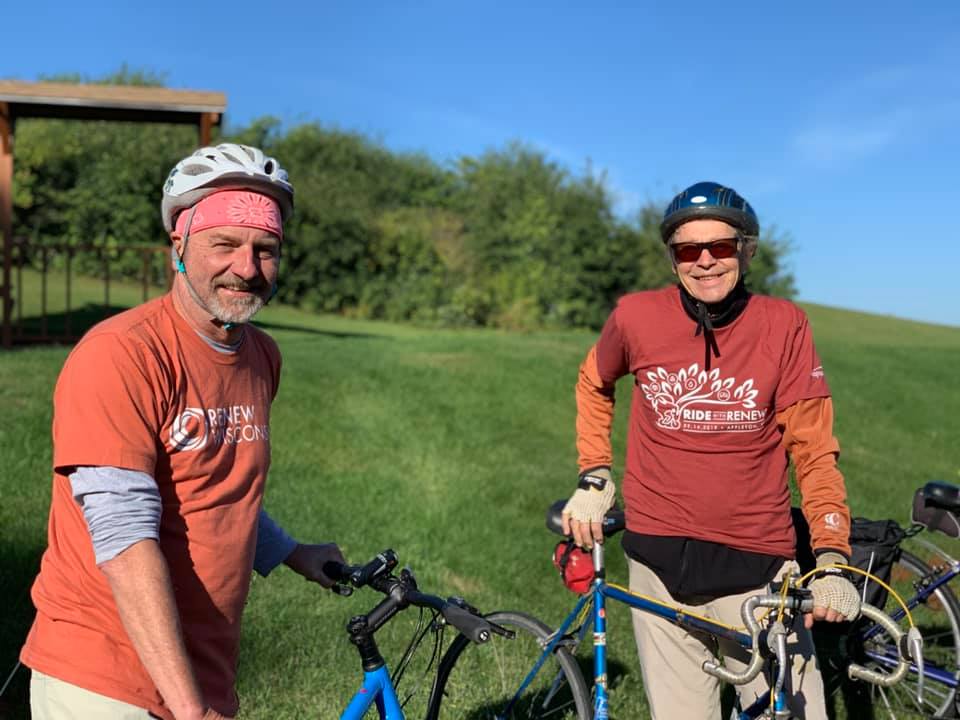
Our bike riders and Girl Scouts then set out for the Bubolz Nature Center where we explored their solar panels and microgrid, built and operated by Faith Technologies, who walked us through this one-of-a-kind facility in Wisconsin. The microgrid includes a lithium battery, a hydrogen fuel cell, and a generator, and the facility runs off the solar panels and renewable storage most of the time.

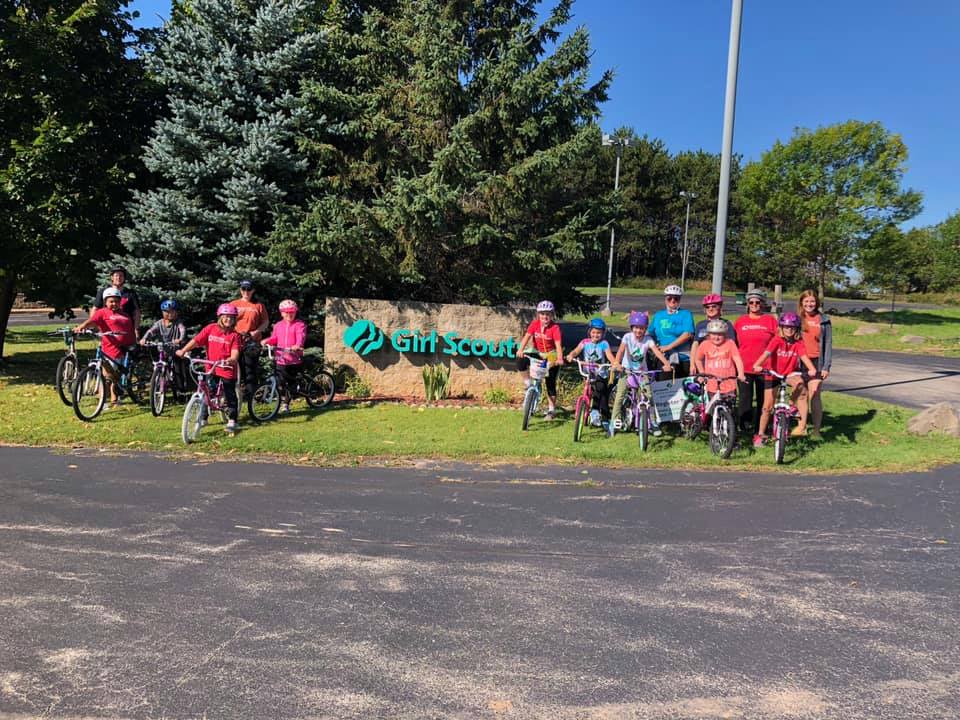
Next we biked 10 miles to Evergreen Credit Union which has become a regional leader in sustainability. With solar panels covering its roof, Roni Kasperek of Evergreen described the credit union’s migration to becoming a clean energy leader and how sustainability is a core value of the organization.
We turned Schildt Park into a clean energy mecca at lunch! Featuring pizza from Glass Nickel Pizza, we were fortunate to have the Ripon Lego League join us as they collected data from our bike riders to help them with their Lego challenge of designing a sustainable community! Our riders engaged in the Lego League’s survey, created to help the kids better understand bikers’ safety needs and how a city could better support bicycling. The Lego League kids did a great job helping to serve lunch and engage with our bikers!
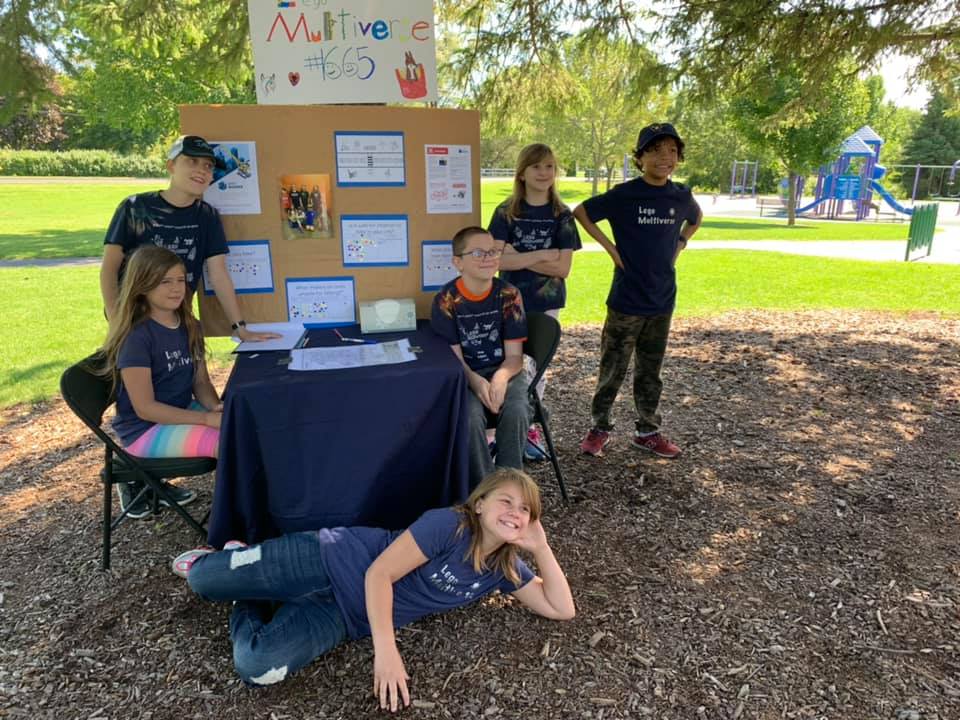
In addition, we had an electric vehicle exposition featuring 9 vehicles from 5 car brands that drive with electricity, instead of gasoline. This technology is advancing and many new types of affordable electric vehicles are coming out soon. We loved showing these cars off to our bike riders and a few members of the public, and the vehicle owners loved chatting about how much they enjoy driving electric.
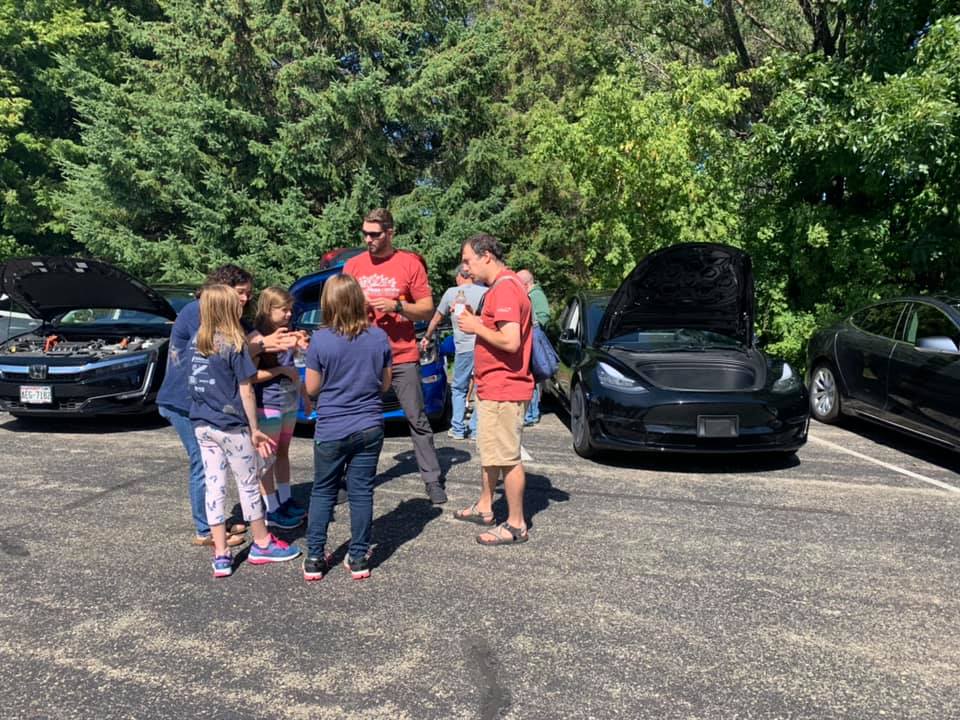
After lunch we saw small wind turbines at Essity (formerly SCA Tissue) right along the bike path. These 4 turbines were designed and installed by a former Wisconsin company called Renewegy (which is unfortunately no longer in business). Next we headed to Heckrodt Wetland Reserve in Menasha where we learned about their tremendous efforts to preserve this part of the state and how solar power is a sustainable part of their growth.
We next saw an innovative solar carport at the Petit and Dommershausen law offices in downtown Menasha, where were treated to a much-needed snack. Then we biked to RiverHeath, which is a new development in Appleton right along the Fox River. Mike Barnett of HGA described an innovative use of geothermal energy, designed by HGA and installed by G.O. Loop, that uses the temperature of the water to provide heating and cooling to the new buildings in the RiverHeath complex.
Last, but certainly not least, we biked to the first power plant in Wisconsin that delivered electricity to a customer. We were greeted by “Thomas Edison,” a generous measure provided by the Appleton Historical Society, who helped explain the origins of the Vulcan Street Hydropower Plant which was put into service in 1882 and provided electricity for lights at paper manufacturing plants as well as one home.
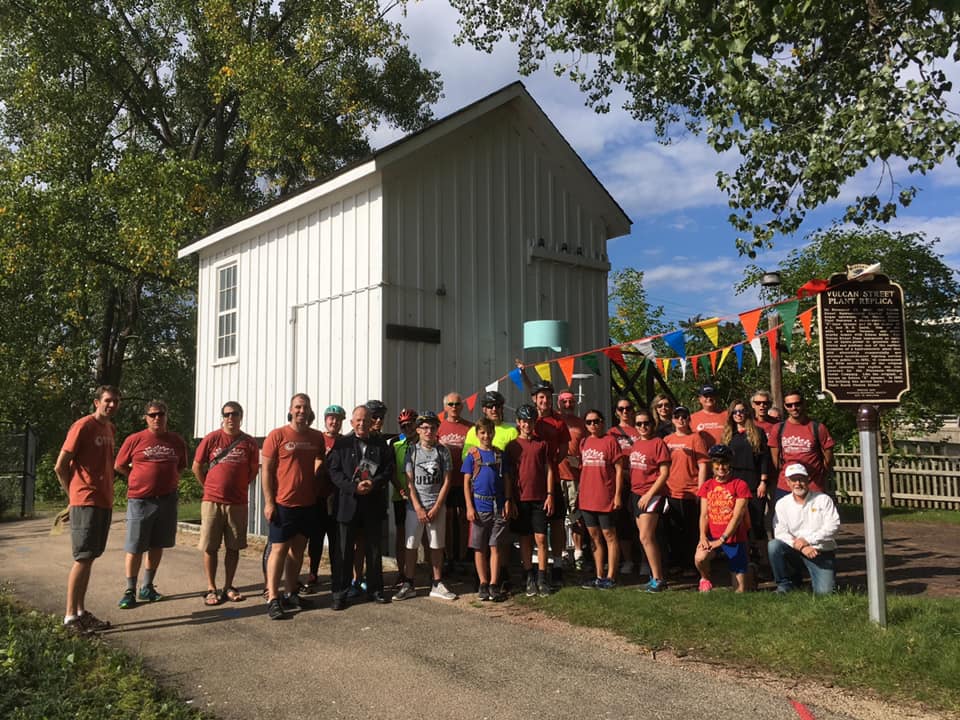
The actual Vulcan plant burned down in 1889. The Appleton Historical Society, as well as Ford Motor Company, contributed many hours and, in Ford’s case, equipment, to allow this replica of the original hydropower plant in Wisconsin to stand and to give visitors like us the opportunity to learn about Wisconsin’s energy history and see it in action.
Finally, we arrived back at Prairie Hill Park, where we enjoyed beer from Central Waters based in Amherst and celebrated a great event with our riders! The weather was outstanding, and we can’t wait to plan next year’s Ride with RENEW.
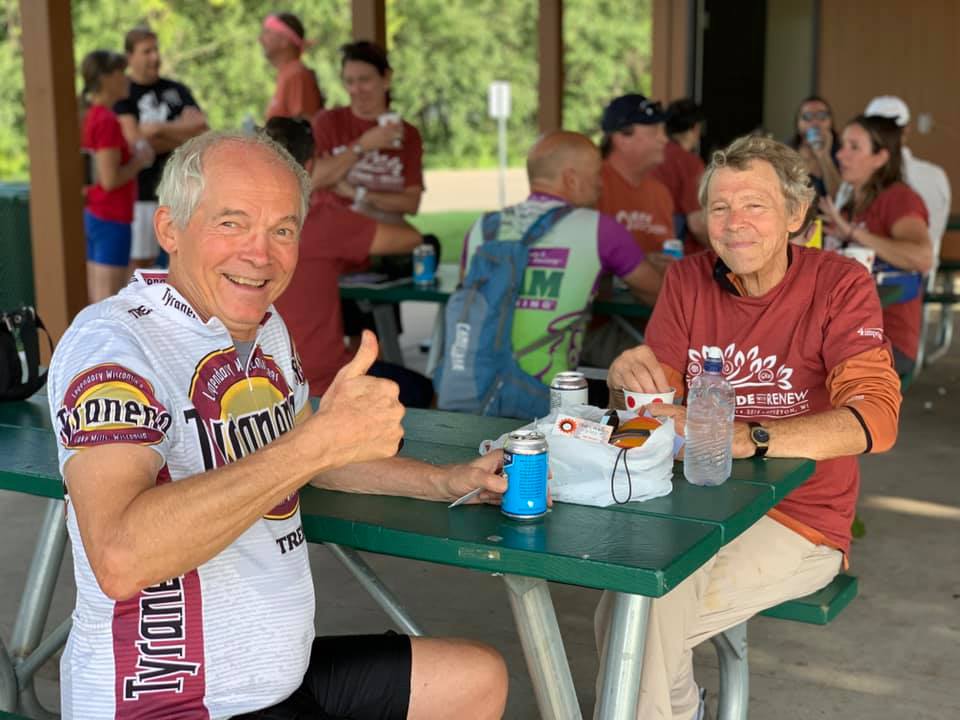
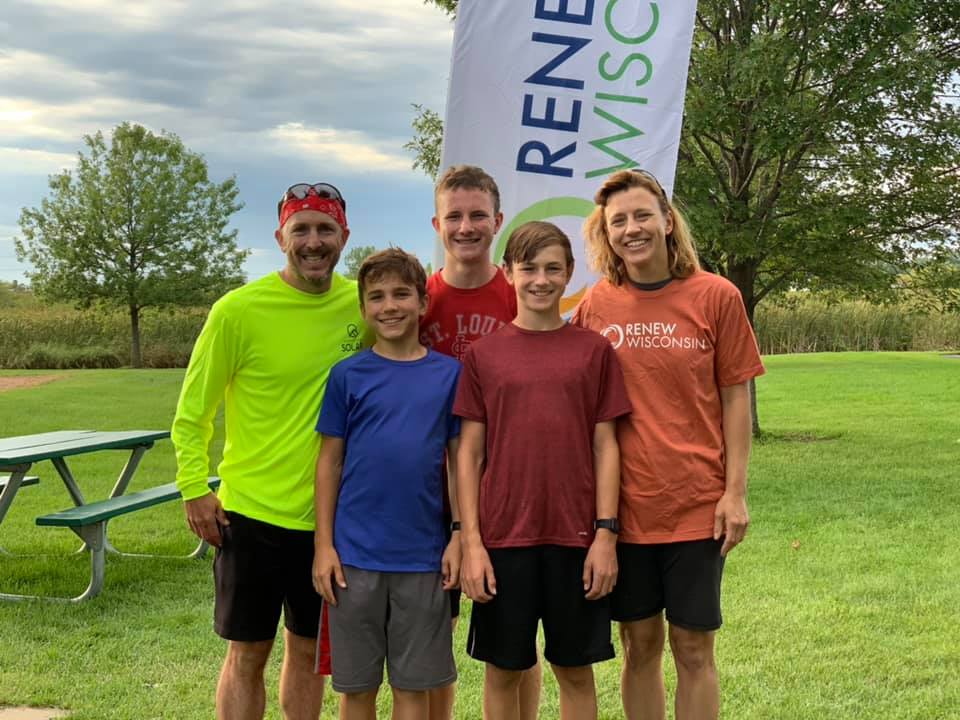
Four of RENEW staff members joined Board member Jim Funk of Energize LLC as he showed off one of Wisconsin’s earliest examples of “bi-facial” solar panels – panels that can receive light from both sides of the panel to create electricity. This installation at a carport has served as a beautiful visual example of solar energy in the Fox Cities since 2010. For example, check out the very cool design when our staff member Jim Boullion’s car was parked underneath the panels.
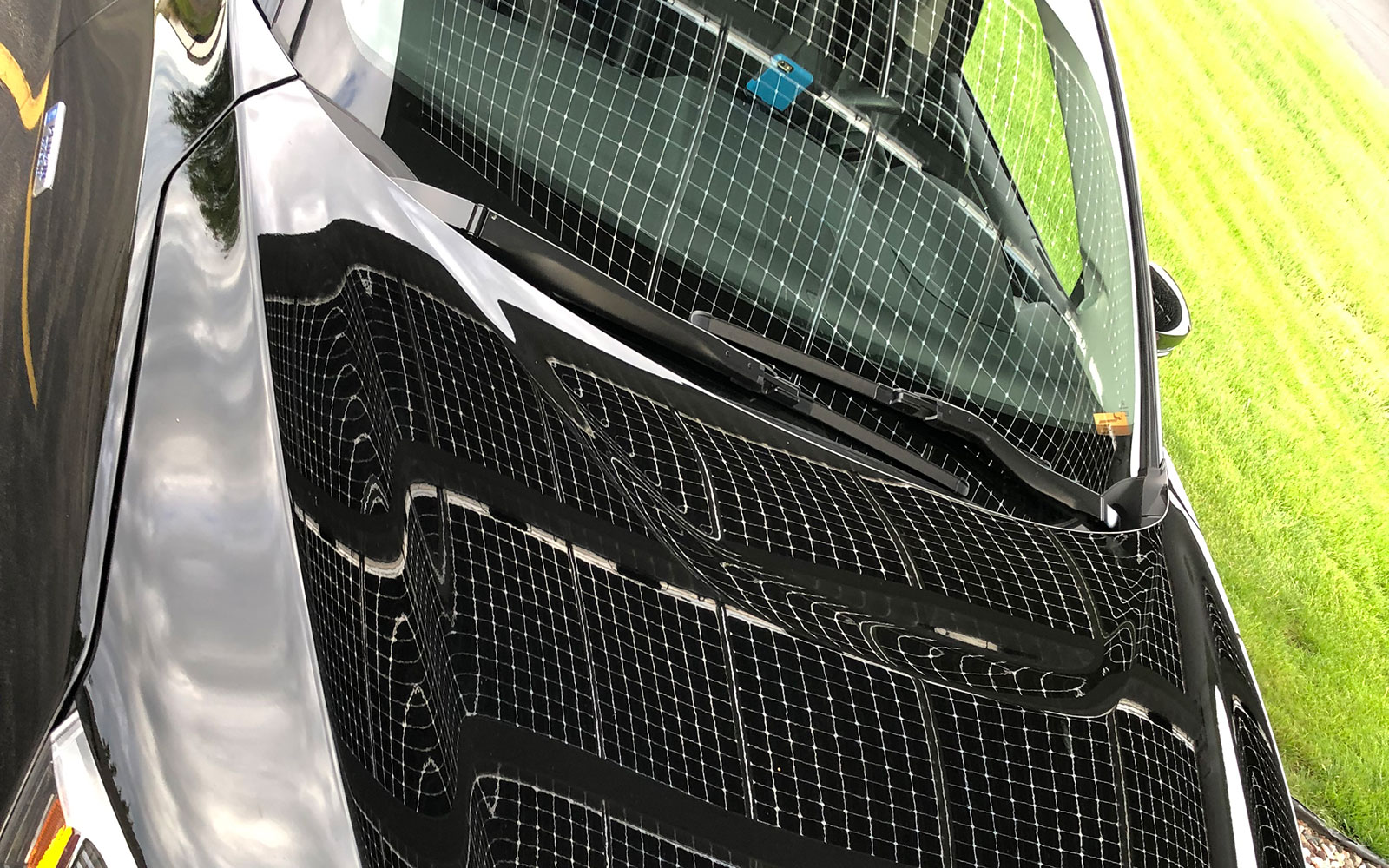
Check out our Facebook photo album to see more images of the ride!
Thank you again to all of our sponsors, shown below, all the bike riders, the Girl Scouts, Lego League, and everyone who donated to support our riders and helped us raise over $17,000 to continue our education, advocacy, and collaboration to advance renewable energy in Wisconsin!
2019 RIDE WITH RENEW SPONSORS




















